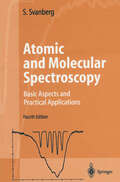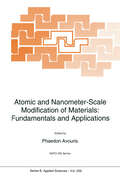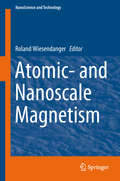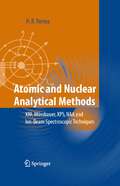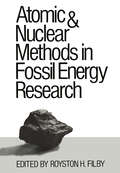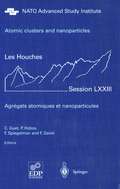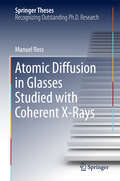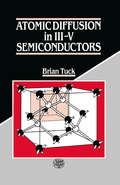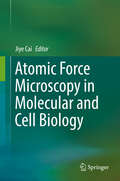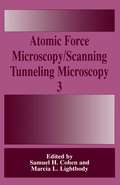- Table View
- List View
Atomic and Molecular Spectroscopy: Basic Aspects and Practical Applications (Advanced Texts in Physics)
by Sune SvanbergA wide-ranging review of modern spectroscopic techniques such as X-ray, photoelectron, optical and laser spectroscopy, and radiofrequency and microwave techniques. On the fundamental side the book focuses on physical principles and the impact of spectroscopy on our understanding of the building blocks of matter, while in the area of applications particular attention is given to those in chemical analysis, photochemistry, surface characterisation, environmental and medical diagnostics, remote sensing and astrophyscis. The Fourth Edition also provides the reader with an update on laser cooling and trapping, Bose-Einstein condensation, ultra-fast spectroscopy, high-power laser/matter interaction, satellite-based astronomy and spectroscopic aspects of laser medicine.
Atomic and Nano Scale Materials for Advanced Energy Conversion
by Zongyou YinAtomic and Nano Scale Materials for Advanced Energy Conversion Discover the latest advancements in energy conversion technologies used to develop modern sustainable energy techniques In Atomic and Nano Scale Materials for Advanced Energy Conversion, expert interdisciplinary researcher Dr. Zongyou Yin delivers a comprehensive overview of nano-to-atomic scale materials science, the development of advanced electrochemical, photochemical, photoelectrochemical, and photovoltaic energy conversion strategies, and the applications for sustainable water splitting and other technologies. The book offers readers cutting-edge information of two-dimensional nano, mixed-dimensional nano, nano rare earth, clusters, and single atoms. It constructively evaluates emerging nano-to-atomic scale energy conversion technologies for academic research and development (R&D) researchers and industrial technique consultants and engineers. The author sets out a systematic analysis of recent energy-conversion science, covering topics like adaptable manufacturing of Van der Waals heterojunctions, mixed-dimensional junctions, tandem structures, and superlattices. He also discusses function-oriented engineering in polymorphic phases, photon absorption, excitons-charges conversion, non-noble plasmonics, and solid-liquid-gas interactions. Readers will also benefit from: A thorough introduction to emerging nanomaterials for energy conversion, including electrochemical, photochemical, photoelectrochemical, and photovoltaic energy conversion An exploration of clusters for energy conversion, including electrochemical, photochemical, and photoelectrochemical clusters Practical discussions of single atoms for energy conversion in electrochemical, photochemical, and photoelectrochemical energy conversion technologies A thorough analysis of future perspectives and directions in advanced energy conversion technology Perfect for materials scientists, photochemists, electrochemists, and inorganic chemists, Atomic and Nano Scale Materials for Advanced Energy Conversion is also a must-read resource for catalytic chemists interested in the intersection of advanced chemistry and physics in energy conversion technologies.
Atomic and Nano Scale Materials for Advanced Energy Conversion
by Zongyou YinAtomic and Nano Scale Materials for Advanced Energy Conversion Discover the latest advancements in energy conversion technologies used to develop modern sustainable energy techniques In Atomic and Nano Scale Materials for Advanced Energy Conversion, expert interdisciplinary researcher Dr. Zongyou Yin delivers a comprehensive overview of nano-to-atomic scale materials science, the development of advanced electrochemical, photochemical, photoelectrochemical, and photovoltaic energy conversion strategies, and the applications for sustainable water splitting and other technologies. The book offers readers cutting-edge information of two-dimensional nano, mixed-dimensional nano, nano rare earth, clusters, and single atoms. It constructively evaluates emerging nano-to-atomic scale energy conversion technologies for academic research and development (R&D) researchers and industrial technique consultants and engineers. The author sets out a systematic analysis of recent energy-conversion science, covering topics like adaptable manufacturing of Van der Waals heterojunctions, mixed-dimensional junctions, tandem structures, and superlattices. He also discusses function-oriented engineering in polymorphic phases, photon absorption, excitons-charges conversion, non-noble plasmonics, and solid-liquid-gas interactions. Readers will also benefit from: A thorough introduction to emerging nanomaterials for energy conversion, including electrochemical, photochemical, photoelectrochemical, and photovoltaic energy conversion An exploration of clusters for energy conversion, including electrochemical, photochemical, and photoelectrochemical clusters Practical discussions of single atoms for energy conversion in electrochemical, photochemical, and photoelectrochemical energy conversion technologies A thorough analysis of future perspectives and directions in advanced energy conversion technology Perfect for materials scientists, photochemists, electrochemists, and inorganic chemists, Atomic and Nano Scale Materials for Advanced Energy Conversion is also a must-read resource for catalytic chemists interested in the intersection of advanced chemistry and physics in energy conversion technologies.
Atomic and Nanometer-Scale Modification of Materials: Fundamentals and Applications (NATO Science Series E: #239)
by P. AvourisThis volume contains the proceedings of the conference on "Atomic and Nanometer Scale Modification of Materials: Fundamentals and Applications" which was co-sponsored by NATO and the Engineering Foundation, and took place in Ventura, California in August 1992. The goal of the organizers was to bring together and facilitate the exchange of information and ideas between researchers involved in the development of techniques for nanometer-scale modification and manipulation. theorists investigating the fundamental mech anisms of the processes involved in modification, and scientists studying the properties and applications of nanostructures. About seventy scientists from all over the world participated in the conference. It has been more than 30 years since Richard Feynman wrote his prophetic article: ''There is Plenty of Room at the Bottom" (Science and Engineering, 23, 22, 1960). In it he predicted that some day we should be able to store bits of information in structures composed of only 100 atoms or so, and thus be able to write all the information accumulated in all the books in the world in a cube of material one two-hundredths of an inch high. He went on to say, "the prin ciples of physics, as far as I can see, do not speak against the possibility of maneuvering things atom by atom. " Since that time there has been significant progress towards the realization of Feynman's dreams.
Atomic- and Nanoscale Magnetism (NanoScience and Technology)
by Roland WiesendangerThis book provides a comprehensive overview of the fascinating recent developments in atomic- and nanoscale magnetism, including the physics of individual magnetic adatoms and single spins, the synthesis of molecular magnets for spintronic applications, and the magnetic properties of small clusters as well as non-collinear spin textures, such as spin spirals and magnetic skyrmions in ultrathin films and nanostructures. Starting from the level of atomic-scale magnetic interactions, the book addresses the emergence of many-body states in quantum magnetism and complex spin states resulting from the competition of such interactions, both experimentally and theoretically. It also introduces novel microscopic and spectroscopic techniques to reveal the exciting physics of magnetic adatom arrays and nanostructures at ultimate spatial and temporal resolution and demonstrates their applications using various insightful examples. The book is intended for researchers and graduate students interested in recent developments of one of the most fascinating fields of condensed matter physics.
Atomic and Nuclear Analytical Methods: XRF, Mössbauer, XPS, NAA and Ion-Beam Spectroscopic Techniques
by Hem Raj VermaThis book compares and offers a comprehensive overview of nine analytical techniques important in material science and many other branches of science. All these methods are already well adapted to applications in diverse fields such as medical, environmental studies, archaeology, and materials science. This clearly presented reference describes and compares the principles of the methods and the various source and detector types.
Atomic clusters and nanoparticles. Agregats atomiques et nanoparticules: Les Houches Session LXXIII 2-28 July 2000 (Les Houches - Ecole d'Ete de Physique Theorique #73)
by C. Guet P. Hobza F. Spiegelman F. DavidFocused on basic science, this book reviews experiments on metal clusters in two long pedagogically written articles. Interested readers will also find articles ranging from density functional theory to computer simulations of cluster dynamics.
Atomic Diffusion in Glasses Studied with Coherent X-Rays (Springer Theses)
by Manuel RossThis thesis provides the first successful study of jump diffusion processes in glasses on the atomic scale, utilizing a novel coherent technique. This new method, called atomic-scale X-ray Photon Correlation Spectroscopy or aXPCS, has only recently been proven to be able to capture diffusion processes with atomic resolution in crystal systems.With this new toolkit for studying atomic diffusion in amorphous systems, new insight into basic processes in a wide range of technically relevant materials, like fast ionic conductors, can be obtained.
Atomic Diffusion in III-V Semiconductors
by Brian TuckIII-V semiconductors, of which gallium arsenide is the best known, have been important for some years and appear set to become much more so in the future. They have principally contributed to two technologies: microwave devices and optoelectronics. Recent advances in the production of thin layers have made possible a whole new range of devices based on multi-quantum wells. The heat treatments used in the manufacture of semiconductor devices means that some diffusion must take place. A good understanding of diffusion processes is therefore essential to maintain control over the technology. Atomic Diffusion in III-V Semiconductors presents a lucid account of the experimental work that has been carried out on diffusion in III-Vs and explores the advanced models that explain the results. A review of the III-V group of semiconductors outlines the special properties that make them so attractive for some types of devices. Discussion of the basic elements of diffusion in semiconductors provides the theory necessary to understand the subject in depth, and the book gives hints on how to assess the published data. Chapters on diffusion of shallow donors, shallow acceptors, transition elements, and very fast-diffusing elements provide a critical review of published works. The book also presents the neglected subject of self-diffusion, including a section on superlattices. Atomic Diffusion in III-V Semiconductors will be of interest to research workers in semiconductor science and technology, and to postgraduate students in physics, electronics, and materials science.
Atomic Diffusion in III-V Semiconductors
by Brian TuckIII-V semiconductors, of which gallium arsenide is the best known, have been important for some years and appear set to become much more so in the future. They have principally contributed to two technologies: microwave devices and optoelectronics. Recent advances in the production of thin layers have made possible a whole new range of devices based on multi-quantum wells. The heat treatments used in the manufacture of semiconductor devices means that some diffusion must take place. A good understanding of diffusion processes is therefore essential to maintain control over the technology. Atomic Diffusion in III-V Semiconductors presents a lucid account of the experimental work that has been carried out on diffusion in III-Vs and explores the advanced models that explain the results. A review of the III-V group of semiconductors outlines the special properties that make them so attractive for some types of devices. Discussion of the basic elements of diffusion in semiconductors provides the theory necessary to understand the subject in depth, and the book gives hints on how to assess the published data. Chapters on diffusion of shallow donors, shallow acceptors, transition elements, and very fast-diffusing elements provide a critical review of published works. The book also presents the neglected subject of self-diffusion, including a section on superlattices. Atomic Diffusion in III-V Semiconductors will be of interest to research workers in semiconductor science and technology, and to postgraduate students in physics, electronics, and materials science.
Atomic Energy Costing (Topics in Regulatory Economics and Policy #29)
by Warren YoungIn the centennial year of the birth of Sir John Cockcroft, first master of my Cam bridge College, Churchill, and the first man to split the atomic nucleus by artificial means, it is indeed relevant to consider the outcome of his efforts at developing atomic power. From the earliest days of the construction of Calder Hall-the first nuclear power station in Britain-and the establishment of the British Atomic Re search Center at Harwell, and the Chalk River Nuclear Station in Canada, through the "Windscale" nuclear accident in Britain, up to the present, when some 20% of UK energy is derived from nuclear power, the Cockcroft legacy is felt. As the British historian Mark Goldie put it, in the "pure and sanguine 1950s," Cockcroft had almost absolute "faith in 'peaceful atoms' and in the boundless, almost cost free, energy that atoms would soon produce" (Goldie, 1997, p. 21). But, as the eminent economist Frank Hahn recalled, "the only failing Cockcroft had" was "that he wasn't up to much in economics. " Indeed, Hahn recalled that he "had to explain" to Cockcroft "the economic notion of optimum durability" as it related to the "interest rate" in the context of building Churchill College with "hand-made bricks. " After his explana tion, as Hahn recalled "Cockcroft smiled and proceeded to order more hand-made bricks" (Hahn, 1997, p. 27).
Atomic Force Microscopy: Fundamental Concepts and Laboratory Investigations
by Wesley C. SandersThis book focuses primarily on the atomic force microscope and serves as a reference for students, postdocs, and researchers using atomic force microscopes for the first time. In addition, this book can serve as the primary text for a semester-long introductory course in atomic force microscopy. There are a few algebra-based mathematical relationships included in the book that describe the mechanical properties, behaviors, and intermolecular forces associated with probes used in atomic force microscopy. Relevant figures, tables, and illustrations also appear in each chapter in an effort to provide additional information and points of interest. This book includes suggested laboratory investigations that provide opportunities to explore the versatility of the atomic force microscope. These laboratory exercises include opportunities for experimenters to explore force curves, surface roughness, friction loops, conductivity imaging, and phase imaging.
Atomic Force Microscopy: Fundamental Concepts and Laboratory Investigations
by Wesley C. SandersThis book focuses primarily on the atomic force microscope and serves as a reference for students, postdocs, and researchers using atomic force microscopes for the first time. In addition, this book can serve as the primary text for a semester-long introductory course in atomic force microscopy. There are a few algebra-based mathematical relationships included in the book that describe the mechanical properties, behaviors, and intermolecular forces associated with probes used in atomic force microscopy. Relevant figures, tables, and illustrations also appear in each chapter in an effort to provide additional information and points of interest. This book includes suggested laboratory investigations that provide opportunities to explore the versatility of the atomic force microscope. These laboratory exercises include opportunities for experimenters to explore force curves, surface roughness, friction loops, conductivity imaging, and phase imaging.
Atomic Force Microscopy: A New Look at Microbes (Synthesis Lectures on Materials and Optics)
by Ahmed TouhamiOver the last two decades, Atomic Force Microscopy (AFM) has undoubtedly had a considerable impact in unraveling the structures and dynamics of microbial surfaces with nanometer resolution, and under physiological conditions. Moreover, the continuous innovations in AFM-based modalities as well as the combination of AFM with modern optical techniques, such as confocal fluorescence microscopy or Raman spectroscopy, increased the diversity and volume of data that can be acquired in an experiment. It is evident that these combinations provide new ways to investigate a broad spectrum of microbiological processes at the level of single cells. In this book, I have endeavored to highlight the wealth of AFM-based modalities that have been implemented over the recent years leading to the multiparametric and multifunctional characterization of, specifically, bacterial surfaces. Examples include the real-time imaging of the nanoscale organization of cell walls, the quantification of subcellular chemical heterogeneities, the mapping and functional analysis of individual cell wall constituents, and the probing of the nanomechanical properties of living bacteria. It is expected that in the near future more AFM-based modalities and complementary techniques will be combined into single experiments to address pertinent problems and challenges in microbial research. Such improvements may make it possible to address the dynamic nature of many more microbial cell surfaces and their constituents, including the restructuring of cellular membranes, pores and transporters, signaling of cell membrane receptors, and formation of cell-adhesion complexes. Ultimately, manifold discoveries and engineering possibilities will materialize as multiparametric tools allow systems of increasing complexity to be probed and manipulated.
Atomic Force Microscopy (NanoScience and Technology)
by Bert VoigtländerThis book explains the operating principles of atomic force microscopy with the aim of enabling the reader to operate a scanning probe microscope successfully and understand the data obtained with the microscope. This enhanced second edition to "Scanning Probe Microscopy" (Springer, 2015) represents a substantial extension and revision to the part on atomic force microscopy of the previous book. Covering both fundamental and important technical aspects of atomic force microscopy, this book concentrates on the principles the methods using a didactic approach in an easily digestible manner. While primarily aimed at graduate students in physics, materials science, chemistry, nanoscience and engineering, this book is also useful for professionals and newcomers in the field, and is an ideal reference book in any atomic force microscopy lab.
Atomic Force Microscopy Based Nanorobotics: Modelling, Simulation, Setup Building and Experiments (Springer Tracts in Advanced Robotics #71)
by Hui Xie Cagdas Onal Stéphane Régnier Metin SittiThe atomic force microscope (AFM) has been successfully used to perform nanorobotic manipulation operations on nanoscale entities such as particles, nanotubes, nanowires, nanocrystals, and DNA since 1990s. There have been many progress on modeling, imaging, teleoperated or automated control, human-machine interfacing, instrumentation, and applications of AFM based nanorobotic manipulation systems in literature. This book aims to include all of such state-of-the-art progress in an organized, structured, and detailed manner as a reference book and also potentially a textbook in nanorobotics and any other nanoscale dynamics, systems and controls related research and education. Clearly written and well-organized, this text introduces designs and prototypes of the nanorobotic systems in detail with innovative principles of three-dimensional manipulation force microscopy and parallel imaging/manipulation force microscopy.
Atomic Force Microscopy in Molecular and Cell Biology
by Jiye CaiThe book addresses new achievements in AFM instruments – e.g. higher speed and higher resolution – and how AFM is being combined with other new methods like NSOM, STED, STORM, PALM, and Raman. This book explores the latest advances in atomic force microscopy and related techniques in molecular and cell biology. Atomic force microscopy (AFM) can be used to detect the superstructures of the cell membrane, cell morphology, cell skeletons and their mechanical properties. Opening up new fields of in-situ dynamic study for living cells, enzymatic reactions, fibril growth and biomedical research, these combined techniques will yield valuable new insights into molecule and cell biology. This book offers a valuable resource for students and researchers in the fields of biochemistry, cell research and chemistry etc.
Atomic Force Microscopy, Scanning Nearfield Optical Microscopy and Nanoscratching: Application to Rough and Natural Surfaces (NanoScience and Technology)
by Gerd KauppMaking a clear distinction is made between nano- and micro-mechanical testing for physical reasons, this monograph describes the basics and applications of the supermicroscopies AFM and SNOM, and of the nanomechanical testing on rough and technical natural surfaces in the submicron range down to a lateral resolution of a few nm. New or improved instrumentation, new physical laws and unforeseen new applications in all branches of natural sciences (around physics, chemistry, mineralogy, materials science, biology and medicine) and nanotechnology are covered as well as the sources for pitfalls and errors. It outlines the handling of natural and technical samples in relation to those of flat standard samples and emphasizes new special features. Pitfalls and sources of errors are clearly demonstrated as well as their efficient remedy when going from molecularly flat to rough surfaces. The academic or industrial scientist learns how to apply the principles for tackling their scientific or manufacturing tasks that include roughness far away from standard samples.
Atomic Force Microscopy/Scanning Tunneling Microscopy
by M. T. Bray Samuel H. Cohen Marcia L. LightbodyThe first U. S. Army Natick Research, Development and Engineering Center Atomic Force/Scanning Tunneling Microscopy (AFM/STM) Symposium was held on lune 8-10, 1993 in Natick, Massachusetts. This book represents the compilation of the papers presented at the meeting. The purpose ofthis symposium was to provide a forum where scientists from a number of diverse fields could interact with one another and exchange ideas. The various topics inc1uded application of AFM/STM in material sciences, polymers, physics, biology and biotechnology, along with recent developments inc1uding new probe microscopies and frontiers in this exciting area. The meeting's format was designed to encourage communication between members of the general scientific community and those individuals who are at the cutting edge of AFM, STM and other probe microscopies. It immediately became clear that this conference enabled interdisciplinary interactions among researchers from academia, industry and government, and set the tone for future collaborations. Expert scientists from diverse scientific areas including physics, chemistry, biology, materials science and electronics were invited to participate in the symposium. The agenda of the meeting was divided into three major sessions. In the first session, Biological Nanostructure, topics ranged from AFM ofDNA to STM imagmg ofthe biomoleeule tubulin and bacterialluciferase to the AFM of starch polymer double helices to AFM imaging of food surfaces.
Atomic Force Microscopy/Scanning Tunneling Microscopy 2
by Samuel H. Cohen Marcia L. LightbodyThis book represents the compilation of papers presented at the second Atomic Force Microscopy/Scanning Tunneling Microscopy (AFM/STM) Symposium, held June 7 to 9, 1994, in Natick, Massachusetts, at Natick Research, Development and Engineering Center, now part ofU.S. Army Soldier Systems Command. As with the 1993 symposium, the 1994 symposium provided a forum where scientists with a common interest in AFM, STM, and other probe microscopies could interact with one another, exchange ideas and explore the possibilities for future collaborations and working relationships. In addition to the scheduled talks and poster sessions, there was an equipment exhibit featuring the newest state-of-the-art AFM/STM microscopes, other probe microscopes, imaging hardware and software, as well as the latest microscope-related and sample preparation accessories. These were all very favorably received by the meeting's attendees. Following opening remarks by Natick's Commander, Colonel Morris E. Price, Jr., and the Technical Director, Dr. Robert W. Lewis, the symposium began with the Keynote Address given by Dr. Michael F. Crommie from Boston University. The agenda was divided into four major sessions. The papers (and posters) presented at the symposium represented a broad spectrum of topics in atomic force microscopy, scanning tunneling microscopy, and other probe microscopies.
Atomic Force Microscopy/Scanning Tunneling Microscopy 3
by Samuel H. Cohen Marcia L. LightbodyThe Foundation for Advances in Medicine and Science (FAMS), the organizers of SCANNING 98, sponsored its third annual Atomic Force Microscopy/Scanning Tunneling Microscopy Symposium at the Omni Inner Harbor Hotelin Baltimore, Maryland, from May 9 to 12, 1998. This book represents the compilation of papers that were presented at the AFM/STM Symposium as well as a few that were presented at SCANNING 96 and SCANNING 97 meetings that took place in Monterey, California. The purpose of the symposium was to provide an interface between scientists and engineers, representatives of industry, government and academia, all of whom have a common interest in probe microscopies. The meetings offered an ideal forum where ideas could easily be exchanged and where individuals from diverse fields who are on the cutting edge ofprobe microscopy research could communicate with one another. Experts in probe microscopy from around the world representing a wide range of disciplines including physics, biotechnology, nanotechnology, chemistry, material science, etc., were invited to participate. The format of the meeting was structured so as to encourage communication among these individuals. During the first day’s sessions papers were presented on general topics such as application of scanning probe microscopy in materials science; STM and scanning tunneling spectroscopy of organic materials; fractal analysis in AFM; and nanomanipulation. Other papers presented included unexpected ordering of a molecule; synthesis ofpeptides and oligonucleotides; and analysis oflunar soils from Apollo 11.
The Atomic Human: Understanding Ourselves in the Age of AI
by Neil D. Lawrence‘The clarity, authority, wit and insight Lawrence brings to bear are like torches shining into the turbulent darkness of a subject we all wonder at, but which we mostly feel unable to even to think or talk about with any confidence. Hugely recommended’ Stephen FryWhat does Artificial Intelligence mean for our identity? Our fascination with AI stems from the perceived uniqueness of human intelligence. We believe it's what differentiates us. Fears of AI not only concern how it invades our digital lives, but also the implied threat of an intelligence that displaces us from our position at the centre of the world.Neil D. Lawrence's visionary book shows why these fears may be misplaced. Atomism, proposed by Democritus, suggested it was impossible to continue dividing matter down into ever smaller components: eventually we reach a point where a cut cannot be made (the Greek for uncuttable is 'atom'). In the same way, by slicing away at the facets of human intelligence that can be replaced by machines, AI uncovers what is left: an indivisible core that is the essence of humanity.Human intelligence has evolved across hundreds of thousands of years. Due to our physical and cognitive constraints over that time, it is social and highly embodied. By contrasting our capabilities with machine intelligence, The Atomic Human reveals the technical origins, capabilities and limitations of AI systems, and how they should be wielded. Not just by the experts, but ordinary people. Understanding this will enable readers to choose the future we want – either one where AI is a tool for us, or where we become a tool of AI – and how to counteract the digital oligarchy to maintain the fabric of an open, fair and democratic society.
Atomic Hypothesis and the Concept of Molecular Structure (Tertiary Level Biology)
by L. D. Barron J. E. Boggs Jens Peder Dahl Z. B. Maksic A. Y. Meyer O. E. Polansky B. T. Sutcliffe K. B. Wiberg"Imagination and shrewd guesswork are powerful instruments for acquiring scientific knowledge . . . " 1. H. van't Hoff The last decades have witnessed a rapid growth of quantum chemistry and a tremendous increase in the number of very accurate ab initio calculations of the electronic structure of molecules yielding results of admirable accuracy. This dramatic progress has opened a new stage in the quantum mechanical description of matter at the molecular level. In the first place, highly accurate results provide severe tests of the quantum mecha nics. Secondly, modern quantitative computational ab initio methods can be synergetically combined with various experimen tal techniques thus enabling precise numerical characterization of molecular properties better than ever anticipated earlier. However, the role of theory is not exhausted in disclosing the fundamental laws of Nature and production of ever increasing sets of data of high accuracy. It has to provide additionally a means of systematization, recognition of regularities, and ratio nalization of the myriads of established facts avoiding in this way complete chaos. Additional problems are represented by molecular wavefunctions provided by the modern high-level computational quantum chemistry methods. They involve, in principle, all the information on molecular system, but they are so immensely complex that can not be immediately understood in simple and physically meaningful terms. Both of these aspects, categorization and interpretation, call for conceptual models which should be preferably pictorial, transparent, intuitively appealing and well-founded, being sometimes useful for semi quantitative purposes.
Atomic Information Technology: Safety and Economy of Nuclear Power Plants (Springer Series in Reliability Engineering)
by Taeho WooAtomic Information Technology revaluates current conceptions of the information technology aspects of the nuclear industry. Economic and safety research in the nuclear energy sector are explored, considering statistical methods which incorporate Monte-Carlo simulations for practical applications. Divided into three sections, Atomic Information Technology covers: Atomic economics and management, Atomic safety and reliability, and Atomic safeguarding and security. Either as a standalone volume or as a companion to conventional nuclear safety and reliability books, Atomic Information Technology acts as a concise and thorough reference on statistical assessment technology in the nuclear industry. Students and industry professionals alike will find this a key tool in expanding and updating their understanding of this industry and the applications of information technology within it.
